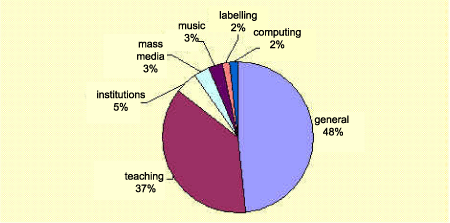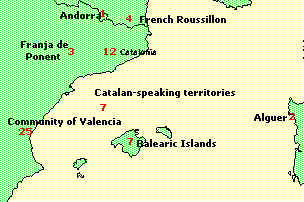
| Sociolingüística catalana |
| Catalan language organizations.
Observations on the language organizations archive and database, by Efrem Sebastià i Ortigosa |
||||
| CONTINUA |
| Results of
the orbservation
The data collated gives us an insight into the situation, distribution, localization and the features of the 62 associations working in the area of language (2) from which we have obtained information. Typologies according to the scope of activity. Given the types of aims and the activities of the organizations, the majority of associations forming part of this project were organizations focusing exclusively on the defence and promotion of the Catalan language. In fact, over half of the organizations fall into the category of language association. However, the study reveals that there are also many associations within the area of culture in general that consider the language question as one of the main subjects of their activity and aims. Almost one third of the associations studied belong to the cultural association category. Table 1 below reveals the number of organizations in each typology: Table 1. Distribution of organizations according to typology
In addition to these typologies, we can differentiate between different areas of activity. We can see how the associations work to standardise the Catalan language in a large number of fields of society. Figure 1 below indicates the proportion of the organizations that work to promote and foster the language in general, and of those organizations that focus on a specific area. Although the largest group is that of the general area category, the table reveals a very significant proportion of organizations promoting the language in teaching, with other areas such as institutions, mass media and music lagging further behind. From this observation, we can deduce that the defence of teaching in Catalan is one of the most significant fields in terms of motivating popular organization to defend the language. Figure 1. Distribution of organizations according to area
|

